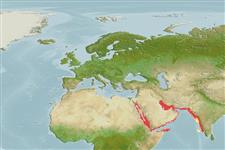Elasmobranchii (tubarões e raias) (sharks and rays) >
Torpediniformes (Electric rays) >
Torpedinidae (Electric rays)
Etymology: Torpedo: Latin, torpere = be sluggish (Ref. 45335).
Environment: milieu / climate zone / depth range / distribution range
Ecologia
marinhas demersal; intervalo de profundidade 1 - 350 m (Ref. 58488). Tropical; 30°N - 11°N, 34°E - 85°E (Ref. 114953)
Western Indian Ocean: Persian Gulf (Ref. 68964) and Red Sea. Reports from other parts of the western Indian Ocean (Bay of Bengal) probably refer to a different species.
Tamanho / Peso / Idade
Maturity: Lm ? range ? - ? cm
Max length : 100.0 cm TL macho/indeterminado; (Ref. 30573)
Descrição suscinta
Morfologia | Morfometria
Espinhos dorsais (total): 0; Espinhos anais 0; Raios anais : 0; Vértebras: 98 - 102. Disc-width shorter than its length, width and length about 1,60 to 1,80 times in total length; dorsal fins more or less rounded, its base 1,25 times in its length (Ref. 39215).
Found on coral reefs; as well as mud or sandy bottoms, from shallow water to a depth of 100 m (Ref. 30573, Ref. 114953). Mainly feeds on invertebrates and small reef fishes (Ref. 114953). Ovoviviparous (Ref. 50449). Males reaches maturity at 28 cm TL (Ref. 114953).
Ciclo de vida ou comportamento de acasalamento
Maturidade | Reprodução | Desova | Ovos | Fecundidade | Larvas
Exhibit ovoviparity (aplacental viviparity), with embryos feeding initially on yolk, then receiving additional nourishment from the mother by indirect absorption of uterine fluid enriched with mucus, fat or protein through specialised structures (Ref. 50449).
Michael, S.W., 1993. Reef sharks and rays of the world. A guide to their identification, behavior, and ecology. Sea Challengers, Monterey, California. 107 p. (Ref. 12951)
Status na Lista Vermelha da UICN (Ref. 130435)
Ameaça para os humanos
Other
Uso pelos humanos
Mais informação
Idade/TamanhoCrescimentoPeso-comprimentoComprimento-comprimentoFrequências de comprimentoMorfometriaMorfologiaLarvasDinâmica larvalRecrutamentoAbundânciaBRUVS
ReferênciasAquaculturaPerfil para aquaculturaEstirpesGenéticaElectrophoresesHereditariedadeDoençasProcessamentoNutrientsConversão de massa
ColaboradoresFotosStamps, Coins Misc.SonsCiguateraVelocidadeTipo de nataçãoÁrea branquialOtólitosCérebrosVisão
Ferramentas
Relatórios especiais
Baixar XML
Fontes da internet
Estimates based on models
Preferred temperature (Ref.
123201): 18.5 - 26.3, mean 23.4 °C (based on 224 cells).
Índice de diversidade filogenética (Ref.
82804): PD
50 = 0.5005 [Uniqueness, from 0.5 = low to 2.0 = high].
Bayesian length-weight: a=0.01479 (0.00659 - 0.03318), b=2.97 (2.78 - 3.16), in cm total length, based on LWR estimates for this (Sub)family-body shape (Ref.
93245).
Nível Trófico (Ref.
69278): 4.6 ±0.8 se; based on size and trophs of closest relatives
Resiliência (Ref.
120179): Muito baixo(a), tempo mínimo de duplicação da população maior que 14 anos (Preliminary K or Fecundity.).
Fishing Vulnerability (Ref.
59153): High vulnerability (60 of 100).
